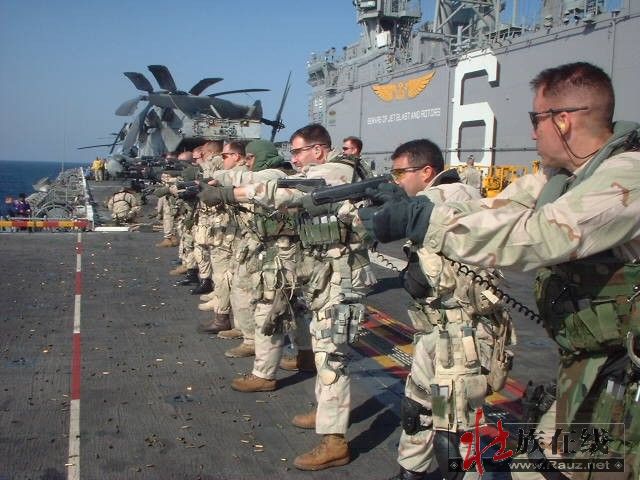










2004年9月12日,一輛美軍布雷德利步兵戰車於巴格達被摧毀著火燃燒,有大批巴格達居民圍著戰車慶祝,並有外國記者探訪。
突然有美軍阿帕奇武裝直昇機出現並向人群開火,一名正在採訪的巴勒斯坦記者濺血到鏡頭上並死去耶。
美軍解釋前後矛盾,先說要摧毀戰車以免精密儀器落入武裝份子手上,後來又改口說有武裝份子混入人群之中向美軍開火云云。
http://www.albasrah.net/images/mortar-attack/bradley.htm

http://www.movie-vault.com/cgi-bin/forum/printthread.php?t=804

http://english.aljazeera.net/NR/exeres/F28D95E6-A0A4-42EE-8072-7A87B45141DB.htm
US: Incendiary weapon used in Iraq
 |
|
Army veterans have described the use of white phosphorous |
Pentagon officials have acknowledged that US troops used white phosphorous as a weapon during the battle of Falluja last November.
At the same time, they denied an Italian television news report that the spontaneously flammable material had been used against civilians.
Lieutenant Colonel Barry Venable, a Pentagon spokesman, said on Tuesday that while white phosphorous was used most frequently to mark targets or obscure positions, it was used at times in Falluja as an incendiary weapon against enemy combatants.
"It was not used against civilians," Venable said.
The spokesman referred reporters to an article in the March-April 2005 edition of the Army's Field Artillery magazine, an official publication, in which veterans of the Falluja fight described their use of white phosphorous and other weapons.
The authors used the shorthand "WP" in referring to white phosphorous.
"WP proved to be an effective and versatile munition," the authors wrote.
"We used it for screening missions at two breeches and, later in the fight, as a potent psychological weapon against the insurgents in trench lines and spider holes when we could not get effects on them with HE (high explosive)" munitions.
"We fired 'shake and bake' missions at the insurgents, using WP to flush them out and HE to take them out."
Deadly fight
"We fired 'shake and bake' missions at the insurgents, using WP to flush them out and HE to take them out"
The authors added, in citing lessons for future urban battles, that fire-support teams should have used another type of smoke bomb for screening missions in Falluja "and saved our WP for lethal missions".
Article in the Army's Field Artillery magazine
The battle for Falluja was the most intense and deadly fight of the war, after the fall of Baghdad in April 2003.
The city, 56km west of Baghdad on the Euphrates River, was a critical stronghold of anti-US fighters.
The authors of the "after action" report said they encountered few civilians in their area of operations.
Burned bodies
Italian communists held a sit-in on Monday in front of the US embassy in Rome to protest against the reported use by American troops of white phosphorous. An ex-marine said he saw burned
Italy's state-run RAI24 news television aired a documentary last week that said the United States used white phosphorous shells in a "massive and indiscriminate way" against civilians during the Falluja offensive.

bodies of women and children
The documentary quoted ex-marine Jeff Englehart as saying he saw the bodies of burned children and women after the bombardments.
"Burned bodies. Burned children and burned women. White phosphorous kills indiscriminately. It's a cloud that, within ... 150 metres of impact, will disperse and will burn every human being or animal."
Initial denial
The State Department initially denied that US troops had used white phosphorous against enemy forces.
The battle for Falluja has been
"They were fired into the air to illuminate enemy positions at night, not at enemy fighters," a department website said. The department later said the statement had been incorrect.

one of the fiercest in Iraq
"There is a great deal of misinformation feeding on itself about US forces allegedly using 'outlawed' weapons in Falluja," the department said.
"The facts are that US forces are not using any illegal weapons in Falluja or anywhere else in Iraq."
Burn injuries
Venable has said white phosphorous shells are a standard weapon used by field artillery units and are not banned by any international weapons convention to which the US is a signatory.
"These weapons are particularly nasty because white phosphorus continues to burn until it disappears... it could burn right down to the bone"
White phosphorous is a colourless-to-yellow translucent wax-like substance with a pungent, garlic-like smell.
Globalsecurity.org
The form used by the military ignites once it is exposed to oxygen, producing such heat that it bursts into a yellow flame and produces a dense white smoke.
Globalsecurity.org, a security and defence thinktank, says: "Phosphorus burns on the skin are deep and painful... The burns usually are multiple, deep, and variable in size. These weapons are particularly nasty because white phosphorus continues to burn until it disappears... it could burn right down to the bone."
Burns frequently are second and third degree, it adds.
| 欢迎光临 僚人家园 (http://bbs.rauz.net.cn/) | Powered by Discuz! X2.5 |